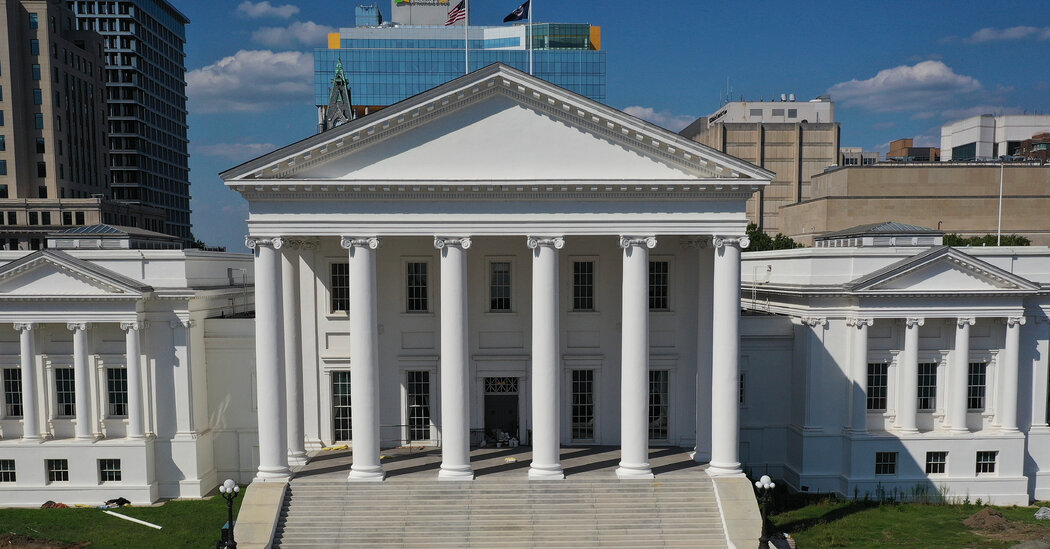Virginia lawmakers are expected to assemble on Monday to start a process that could redraw the state’s congressional districts for the 2026 midterm election.
Virginia is the latest state to plunge into the fight over control of Congress, where Republicans hold a tightrope-slim majority and launched a surprise effort this summer to shore up their control by pushing Republican-led states to redraw congressional districts ahead of schedule.
The effort began in Texas at the behest of President Trump and has touched off months of maneuvering in several states. Missouri and North Carolina have passed new maps to favor Republicans. Leaders in California, a Democratic stronghold, vowed a redistricting push of their own to counter the moves in Republican states.
Virginia, where Democrats control the legislature, appears poised to join the fray in an attempt to swing as many as three of the state’s 11 congressional seats from Republicans to Democrats.
Historically, redistricting has been done after the nation’s once-every-decade census provides a detailed look at changes in population. In most states, redrawing the maps is already a deeply political process, and it has become even more so this year. With Republican control of the U.S. House of Representatives so narrow, and because the party in power typically loses seats in midterms, President Trump and his allies have been moving to redraw districts that would favor Republican candidates.
Redrawing congressional maps in Virginia and California require amendments to the state constitutions. In Virginia, the timeline is tight.
Under its State Constitution, a new amendment has to be approved in two consecutive sessions of the General Assembly, with an election intervening. With a statewide election set for Nov. 4, the current legislature could vote for the amendment this week and then vote again after Jan. 14 when newly elected delegates are seated. If the amendment gets approved in that second vote, it would then need to pass in a statewide referendum.
But the referendum cannot happen for at least 90 days after the new amendment is approved by the legislature. That would mean a vote no earlier than mid-April, just two months before the primaries on June 16, though that schedule could be postponed.
The pressure is compounded by the impending state election. All of the seats in the House of Delegates are up, meaning many of those who will be voting in Richmond this week will be leaving the campaign trail. While the Democrats are favored to hold the House, their current margin is narrow, and the special session adds an unpredictable dynamic in the closing days of the campaign.
That lawmakers could be called back to Richmond so quickly is a quirk of legislative procedure: Gov. Glenn Youngkin, a Republican, called a special session in May 2024 to address the state budget, but that session was never adjourned. Legislators are, technically, gathering this week as part of that year-and-a- half-old special session.
The Democrats have not said publicly that they are convening to pursue a redistricting amendment, even leaving the purpose vague in the letter formally calling the lawmakers back into session. But the aim is no secret.
“Donald Trump started this mess, so we fight fire with fire,” said Louise Lucas, the president pro tempore of the Virginia State Senate, in a social media post on Friday.
To Republicans, having the vote so close to the legislative elections goes against the spirit of the rules. The reason an amendment must be approved by two different legislatures, they argue, is to give Virginia’s voters an opportunity to weigh in between the first and second votes of lawmakers. Hundreds of thousands of Virginians had already voted in this year’s elections.
“In my legal opinion, the election’s already started and it’s too late constitutionally to have such a vote,” Delegate Terry Kilgore, the House Minority Leader, said to reporters on Thursday. “We are going to use everything, legally, everything that we can do to stop this power grab.”
A.E. Dick Howard, who in the late 1960s directed the commission that wrote Virginia’s current Constitution, said that Mr. Kilgore was correct about “the spirit of the arrangement” but that the language of the Constitution did not appear to bar what the Democrats were doing.
The commission, he said, “did not put in place a provision that says you can’t consider the amendment if some people have already voted.”
Governors have no role in the amendment process in Virginia. The outgoing governor, Mr. Youngkin, slammed the Democrats’ plan, pointing out in a social media post that the amendment establishing the state’s nonpartisan redistricting commission passed in 2020 with nearly two-thirds of the vote.
Campaign officials for Abigail Spanberger, the Democratic nominee for governor who is heavily favored to win next week, declined to comment.
Lawmakers and legislative staff members said that the process will likely take all week, with multiple readings required. In Virginia, a quorum is achieved with a simple majority, forestalling the kind of showdown that took place in Texas in June, when Democrats, the minority party there, fled the state to prevent a quorum for a session on redistricting. Still, the Democratic majority in the legislature is slim and includes lawmakers who had been outspoken proponents of nonpartisan redistricting.
Though the Republicans appear to be united in opposition, Democrats say there appear to be limited tools to hinder the process.
“If I had an idea, I wouldn’t tell you,” Delegate Marcus Simon, a Democrat, said.
Ben Paviour contributed reporting.
Campbell Robertson reports for The Times on Delaware, the District of Columbia, Kentucky, Maryland, Ohio, Pennsylvania, Virginia and West Virginia.
The post In Battle for Congress, Virginia Democrats to Begin Votes to Redraw Maps appeared first on New York Times.




